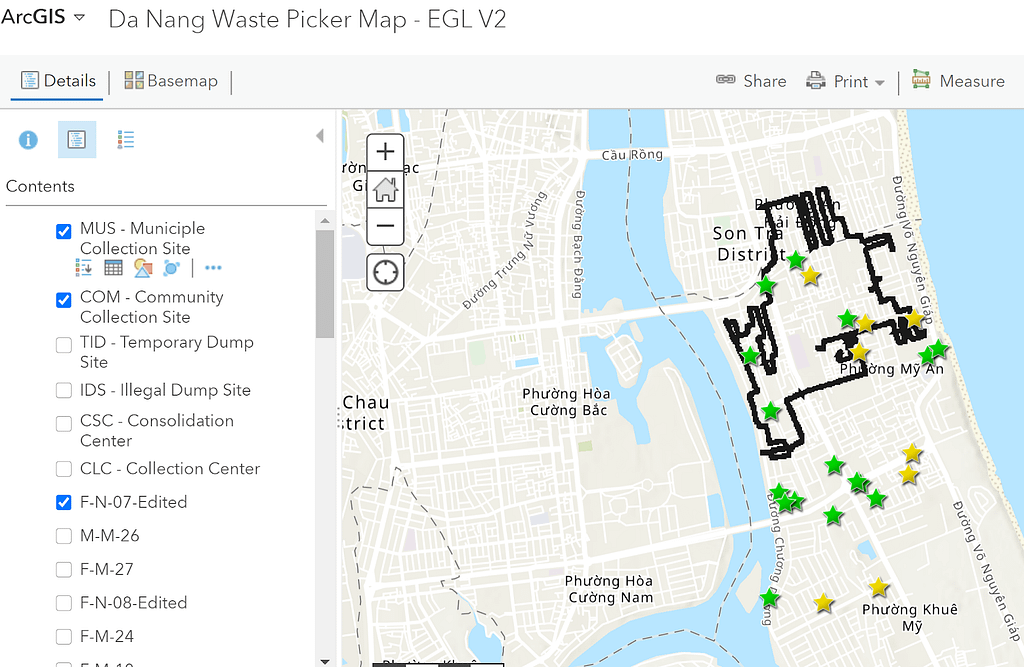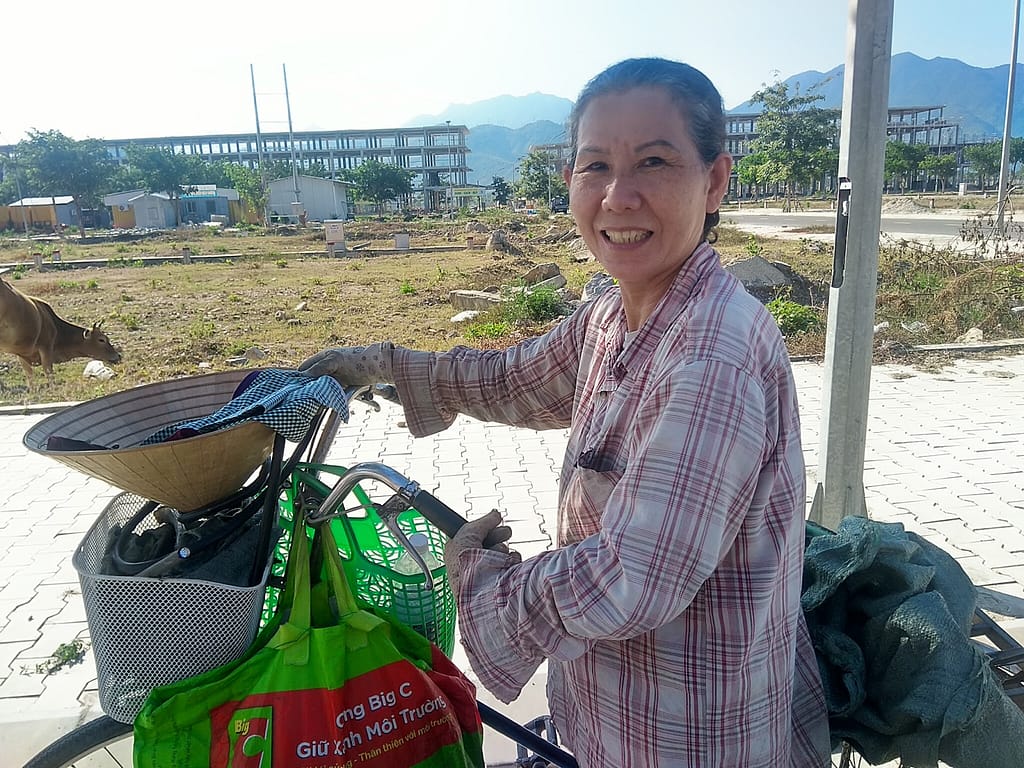
As the sun rises in Hoà Liên commune in Da Nang city , the day begins for 50-year-old Ms. Nguyen Thi Hien. She starts the day around 7 am and she doesn’t return home for another 12 hours at least. First, she hastens to her nearby rice paddy fields, where she is a farmer tending to her crops. Once her fields have been looked after, she bikes over to her main occupation, her small collection center where she recovers, consolidates, and trades recyclable waste. “Before I opened this collection center, I used to be an informal waste worker as well. After going collecting for a few years, I gathered enough business contacts to open this place,” Ms. Hien proudly states. She sorts waste by hand, separating by type of waste mainly distinguishing between paper, metal, and certain types of plastic. That is if she’s not answering the phone, dealing with traders, or noting transactions down in her notebook. It’s a job she has done for over a decade and, “I love my work,” Ms. Hien smiles. Ms. Hien is among thousands of ve chai (informal waste workers) in Viet Nam working around the clock to find value in discarded items — “a person’s trash is another person’s treasure” as the old proverb says.
The informal sector is Viet Nam’s largest contributor towards recycling and reuse of waste in the entire country. Stories just like Ms. Hien’s are common and as one of the top five contributors to plastic waste entering the ocean, Viet Nam needs innovative ways to tackle waste pollution. The informal sector is an active, yet under-used, often misunderstood part of the waste value chain. Toward this end, our UNDP Accelerator Lab teamed up with Evergreen Labs, a solution-driven, project development organization to perform an in-depth study aiming to better understand the informal waste ecosystem with the hope to shed light on their roles and impact. Taking inspiration from Dietmar Offenhuber’s research uncovering Brazil’s informal waste system through GPS data, we conducted two mapping exercises in Hoa Vang (rural district) and Ngu Hanh Son (urban district) as an experiment to gather ethnographic, geospatial and socio-economic data, ultimately help to unpack the nuanced of people working in this sector. During this research, 40 informal waste worker surveys were conducted, 9 routes tracked via GPS, and 39 coverage maps drawn across two districts in Da Nang. The aim was to tap into the collective intelligence of the waste workers guided by NESTA’s Collective Intelligence Playbook to shed light on the informal waste sector.

The current waste streams, collection, and disposal mechanisms in Viet Nam involve various players from both the formal and informal sectors. Household waste is not source-separated, meaning recyclable waste is mixed with organic waste and other contaminants. Typically this waste is left on the curbside in front of businesses or households directly for collection or placed at a designated dumpsite (which can either be municipally managed or not). The informal waste workers (IWWs) are at the front line of recovery and are often seen rummaging through waste to collect all tradeable items like cardboard, metal, and plastic bottles. Once their bike is full, they bring their waste to their nearest collection point, just like Ms. Hien’s, to do their daily trading. Collection centers then consolidate and trade with larger aggregators before the waste gets pre-processed and ready for recycling. This research not only confirmed this value chain but made some interesting discoveries along the way.
Q&A: Demystifying the informal sector

The current waste value chain in Viet Nam has three main endpoints for trash: landfill, environment, or recycling. There is still no official, consistent and scientifically-based data regarding the recycling rate of any kind of waste at a national level in Viet Nam. A National Environment Report published in 2011 estimated the recycling rate of municipal solid waste is approximately 8-12% and mainly taking place by the informal sector in craft villages. Recycling activities within craft villages are manual, outdated, and causing serious environmental and health issues.
How many dumpsites and collection centers are there in a given area? Where are the operation areas of IWW?
These seemingly simple questions are actually quite difficult to answer as most IWWs operate independently and very little data are available from official sources. We conducted this study to map out the geographical activities of informal waste workers, collection centers, and waste hotspots to provide data on their behaviors and habits and ultimately come up with appropriate recommendations for the city. Overall we identified and surveyed a total of 221 locations including165 dumpsites and 56 aggregators in surveyed areas. We then visualized them on the GiS map and categorized them by different types to give an overall impression of the area and provide actionable intel to relevant organizations. In general, we found that IWWs typically concentrate in areas with collection centers/scrap shops to facilitate trading and transportation.




What is the typical profile of an informal waste worker in Viet Nam?
In this study, we found that the average IWW is a middle-aged woman on a bicycle going through neighborhoods to pick up waste either from her established contacts or randomly from households/businesses, earning between 100,000-200,000 VND/day ($4.25-$8.50) . As a group, IWWs are diverse individuals who often take this job due to its freedom, allowing them to supplement their income while having other commitments. Some work on the street to pick up trash, some work at scraps shops to trade valuable waste, other work as business owners as part of the waste supply chain. Take Ms. Dao, one of our interviewees:

“I used to be a construction worker back when a day of labor was worth 21,000 VND (~1 USD), now it is 300,000 VND/day (~13 USD). But I couldn’t do that work anymore and became a waste worker 3 years ago. Everyone has their job, and there has to be someone doing this job.“ Ms. Đào shared with us.
How many IWWs are there in a given area? How do informal waste workers find and collect waste?
Based on our field research observations, we tried to come up with an estimate of IWW numbers operating in Ngu Hanh Son (NHS) and Hoa Vang (HV) districts. We estimated that there were anywhere between 1000-1800 IWWs operating in Da Nang that collect and recycled between 4,31% to 7,49% of total waste in Da Nang during the study period. Even with a rough estimate (the accuracy here is open to debate given more data), it became clear that IWWs have a significant contribution to the city’s effort.
We also found that IWWs do not come in uniform flavor, they each have their own, individual ways of recovering and collecting waste that best suits their abilities, capacity, and needs. While some IWWs solely use their business contacts to pick up available waste, some use a bicycle to slowly ride up and down streets to scavenge household and business waste alike. Which methods result in the best recovery? It depends on the age, skill, and motivation of the individual, and while some have better contacts for access to high-value waste sites (e.g: construction site, landfill) the overall average income of IWWs taken together is nearly the same in the surveyed group.
Do informal waste workers work together?
An established network is the main work resource for any informal waste worker, as Ms. Hien mentioned, “[Once] I gathered enough business contacts to open [my collection center],” showing the significance of networks. As waste picking is not exactly a highly desirable job for most people, IWWs only enter the business with the advising of a trusted contact. While looking for random waste on the street is a common method practiced by most IWWs, key contacts are the result of years of experience working in the sector that helps lighten the workload of IWWs. On the other hand, in rural areas where there is too little waste source, IWWs and local collection centers directly compete against each other to buy waste from the local households and businesses.
How has COVID-19 impacted IWW life?
The IWWs have been deeply affected by the disruption of industry and businesses that typically generate waste such as tourism, food beverage, and construction. In our study, we observe an overall decrease in IWWs presence during COVID-19 time. Many IWW reported that they or their peers had to return to their hometown, find other work, or face unemployment. While there were general health concerns related to their work, medical waste such as single-use masks were not an issue as IWWs, these waste are usually disposed of in the household organic waste bins which IWWs don’t typically go through (for health reasons). Many IWWs did express that they feel left out and unsupported by social welfare policies during the time of COVID-19. All over Viet Nam, informal and seasonal workers are one of the groups most affected by the pandemic, and the social support for them is still found to be inadequate.
The unsung heroes of society
Regardless of their significant contribution, these workers are still viewed in society as dirty, with low societal status, however we hope that by sharing IWWs stories to the world, they can start to gain respect from the society that they deserve. This is also Ms. Hien’s wish as she described, “I do not like it when on TV, whenever informal waste workers are mentioned, they are always portrayed as people in destitute situations. In reality, they are just normal people doing their job. If I see a can or bottle on the street, I would have to look left and right, only if there are no people around that I would pick it up, otherwise I don’t want people to ask me why I do it. I know an IWW that only has one leg. Instead of begging, he rides his bicycle all the way from Hoa Son to here to collect waste. When his bicycle is full, I can feel how heavy it is. He has my respect.”
Through a collective intelligence approach to GIS mapping visualization, it is clear that informal waste workers not only thoroughly cover waste collection in the city (estimated >80% of geographical area coverage) but play a significant role in the overall recovery of recyclable waste, with an estimated total collection between 7.5-9% (taking both IWWs and collection centers into consideration) compared to the total volume brought to the landfill per day (approximately 1000 tons per day) during low volume COVID-19 times (up to 10% more during normalized times). Da Nang city has set a target of reaching a 15% waste recycling rate by 2025, from our rough estimate the informal waste sector is already contributing significantly to the city’s overall goal, but this contribution is not always recognized in the current policies. If the estimate holds true, these figures have a major impact on municipal waste management, and cities around the globe with an informal waste sector should take notice. The waste that is being recovered would either likely end in the City’s landfill or the environment (including the oceans). But the informal sector workers often face ostracization in society due to the stigma of working with waste. In our research, we found great examples around the world of how informal workers were integrated as an asset to the municipal authority such as our sister Lab in Paraguay, the catadore model in Brazil, or the ENDA model of Independent Waste Collectors in Ho Chi Minh City. We hope to see more emergent models like these that integrate and recognize informal sector workers’ true values — our city’s heroes in the fight against waste pollution.
This blog is part of a series exploring the life, roles and contributions of informal waste workers in Viet Nam. It was made possible thanks to the contribution of Evergreen Labs, UNDP Accelerator Lab and Climate Change and Environment teams, NESTA and the generous contributions of informal workers participating in the study.